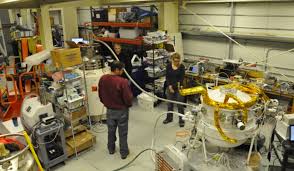Ball Aerospace selected to build key component for NASA balloon mission

BOULDER — Ball Aerospace & Technologies Corp. is designing and building a cryostat for NASA.
The device will be used for the Galactic/ Extragalactic Ultralong Duration Balloon Spectroscopic Terahertz Observatory mission, or GUSTO — essentially, a large balloon with equipment that will be sent into space for an extended period of time.
The mission’s goal is to study remotely dust and material from exploding stars, which form into interstellar clouds until those clouds collapse into new stars, said Bill Purcell, program manager for advanced systems at Boulder-based Ball Aerospace. Observing the material will help to understanding the lifecycle of stars in the Milky Way Galaxy and the chemical formation of that process.
SPONSORED CONTENT
Federal District Court Rules Corporate Transparency Act Unconstitutional . . . But Most Small Businesses Must Still Comply
Lyons Gaddis Real Estate and Business Attorney Cameron Grant shares important details of the Corporate Transparency Act (CTA).
Using the balloon is a relatively low-cost method of observation for NASA, Purcell said.
The GUSTO will launch in December 2021 from McMurdo, Antarctica and will be 110,000 feet up for 170 days.
The mission is led by the University of Arizona and Chris Walker, who Ball has worked with over the past 10 years, providing a cryostat for the shorter Stratospheric Terahertz Observatory, or STO, missions. Indeed, Ball’s cryostats go back to the Gemini and Apollo missions of the 1960s.
The cryostat, Purcell said, is a highly insulated container. “Your coffee thermos is a simple version of a cryostat,” he said. In this case, however, the cryostat is filled with very cold liquid helium, which keeps the detection devices for measuring the stardust the temperature it’s needed to be to get an accurate reading. The cryostat will maintain detectors at the operator temperature of 4.2 Kelvin, or negative 452 degrees Fahrenheit.
“If they’re operated when warm, the actual heat from the detectors themselves is a form of background noise,” Purcell said. “With so much thermal noise, we’d never be able to detect spectral lines. We reduce the background signal by operating at very low temperatures.”
Ball is not disclosing the contract value. Although the GUSTO machine will launch in December 2021, the cryostat Ball is building will be ready before then. It will take 15 months to design and build, and then it will be delivered to the University of Arizona. There, the detectors will be installed inside the cryostat, integrated and tested to ensure everything is working properly before its half-year launch.
BOULDER — Ball Aerospace & Technologies Corp. is designing and building a cryostat for NASA.
The device will be used for the Galactic/ Extragalactic Ultralong Duration Balloon Spectroscopic Terahertz Observatory mission, or GUSTO — essentially, a large balloon with equipment that will be sent into space for an extended period of time.
The mission’s goal is to study remotely dust and material from exploding stars, which form into interstellar clouds until those clouds collapse into new stars, said Bill Purcell, program manager for advanced systems at Boulder-based Ball Aerospace. Observing the material will help to understanding…
THIS ARTICLE IS FOR SUBSCRIBERS ONLY
Continue reading for less than $3 per week!
Get a month of award-winning local business news, trends and insights
Access award-winning content today!

